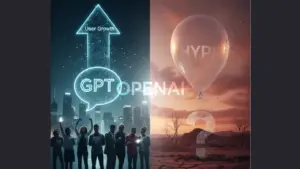Introduction: The AI Dream Turns Into a Crisis
For years, companies believed that artificial intelligence (AI) would change everything. Executives imagined a future where they could replace developers, customer support, and analysts with AI-powered tools. Headlines declared that AI was coming for everyone’s job.
Then reality hit.
Companies that fired developers expecting AI to take over were forced into an embarrassing reversal. Not only did AI fail to replace skilled professionals, but businesses also discovered it introduced a wave of new problems.
Welcome to the AI Implementation Crisis.
The AI Implementation Crisis
AI was supposed to reduce costs. It was supposed to automate complex tasks. Companies thought they could simply plug in tools like ChatGPT and eliminate huge chunks of their workforce.
But the opposite happened.
Job Postings Explode 40% for AI Engineers
The demand for AI engineers grew by 40% year-over-year. Why? Because businesses quickly realized that deploying AI systems isn’t simple. These tools don’t work out of the box. They require expert handling, tuning, testing, and constant monitoring.
Klarna’s AI Mistake
Take Klarna as an example. The company proudly announced they had replaced 40% of their workforce with AI. Weeks later, they admitted that the quality of AI output was lower. Customer experience suffered. They started desperately hiring developers and AI engineers back.
The Plug-and-Play Illusion
Companies assumed AI tools were like hiring a super-smart employee. Just connect it to your system, and magic happens. But AI models are not employees. They are unreliable, context-blind, and error-prone without constant human oversight.
This is why the surge in AI engineering jobs proves a simple fact: AI doesn’t replace developers. It creates entirely new categories of high-paying technical jobs.
The Quality Control Disaster
The most shocking part of the AI hype was how poorly these models performed in real-world tasks.
Basic Errors: AI Can’t Even Count
Tests revealed that ChatGPT, despite its impressive language skills, can’t consistently count to 20. In one case, it skipped the number 14 but insisted it was there.
Now imagine trusting this tool with critical financial data, customer service, or software development. It’s a disaster waiting to happen.
Security Failures at Scale
Security engineers tested the latest AI models for code analysis. Models that scored better on benchmarks were actually worse at real-world debugging and vulnerability detection. The AI failed tasks that junior engineers could easily handle.
More Debugging, More Problems
Development teams reported that AI-generated code requires more debugging and maintenance than code written by experienced developers. In some cases, it was faster to start from scratch than fix what the AI produced.
The Rise of AI Quality Control Roles
New job titles are popping up everywhere:
- AI Prompt Engineer
- AI Output Verifier
- AI Debugging Specialist
These roles exist because the technology is nowhere near autonomous. People are hired specifically to guide, check, and fix what AI produces.
The Emergency Hiring Response
The “AI-first” wave hit hard—and failed just as quickly.
Duolingo’s AI Backlash
When Duolingo announced an AI-first strategy, they expected applause. Instead, they lost over 300,000 followers overnight. Customers didn’t trust AI-led services. Quietly, Duolingo started rehiring human staff within weeks to salvage user trust.
People Prefer Humans
A staggering 80% of customers say they would rather wait for a human than get instant AI-powered help. Companies that laid off teams for AI had no choice but to reverse course.
The Expensive Mistake
By the time companies realized their mistake, the talent market had shifted. Developers and engineers were in high demand. To win them back, businesses had to offer 20–30% higher salaries than before.
The AI Engineer Hiring Boom
The explosion in AI Engineering roles highlights one truth: AI can’t bridge the gap between business needs and technical reality without humans guiding it.
The Integration Nightmare Reality
Most AI tools can generate impressive demos. They can answer questions, write snippets of code, or draft marketing emails. But there’s one huge problem.
AI Works Alone, But Not With You
When companies tried integrating AI into real-world systems, they discovered it failed catastrophically. AI tools couldn’t connect reliably to legacy databases, APIs, customer management systems, or internal dashboards.
Integration Becomes the Real Problem
The hardest part of using AI isn’t generating code. It’s getting AI systems to work with existing business infrastructure. AI might output a sales report or code snippet—but can it plug into your accounting system? Handle edge cases? Update APIs without crashing services?
Usually, the answer is no.
AI Engineering = Software Architecture + AI Complexity
Today’s AI Engineering roles are, in reality, software architecture jobs layered with AI complexity. Engineers must:
- Build custom APIs for AI tools.
- Develop validation pipelines.
- Create monitoring systems to catch AI errors before they hit customers.
- Ensure AI outputs meet security and compliance requirements.
Legacy Meets AI
AI isn’t a magic solution. It’s a fragile, error-prone tool that must be carefully integrated into systems built over decades. That’s why integration specialists, system architects, and AI engineers are now among the highest-demand roles in tech.

Conclusion: The Future of AI Is Human-Centric
The AI gold rush taught businesses a hard lesson: AI doesn’t replace humans—it demands more from them.
Every failed “AI-first” experiment has shown that while AI is powerful, it’s far from autonomous. The real winners in this era are the developers, engineers, and architects who understand both traditional systems and AI’s limitations.




